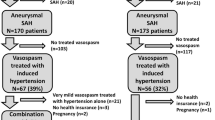Abstract
Purpose
Treatment of acute stroke by endovascular mechanical recanalisation (EMR) has shown promising results and continues to be further refined. We evaluated the impact of a temporary stent compared with our results using other mechanical devices.
Materials and Methods
We analysed clinical and radiological data of all patients who were treated by EMR after intravenous thrombolysis for acute carotid T– and middle-cerebral artery (M1) occlusions at our centre between 2007 and 2011. A comparison was performed between those patients in whom solely the stent-retriever was applied (group S) and those treated with other devices (group C).
Results
We identified 14 patients for group S and 16 patients for group C. Mean age, National Institute of Health Stroke Scale score, and time to treatment were 67.1 years and 16.5 and 4.0 h for group S and 61.1 years and 17.6 and 4.5 h for group C, respectively. Successful recanalisation (thrombolysis in cerebral infarction scores ≥IIb) was achieved in 93% of patients in group S and 56% of patients in group C (P < 0.05). Mean recanalisation times for M1 occlusions were 23 min (group S) and 29 min (group C) and for carotid-T occlusions were 39 min (group S) and 50 min (group C), and 45% of the patients in group S and 33% in group C had a favourable outcome (Modified Rankin Scale score ≤2).
Conclusion
The findings suggest an improvement in recanalisation success by the application of a temporary stent compared with previously used devices. These results are to be confirmed by larger studies.

Similar content being viewed by others
References
Tissue plasminogen activator for acute ischemic stroke (1995) The National Institute of Neurological Disorders and Stroke rt-PA Stroke Study Group. N Engl J Med 333(24):1581–1587
Hacke W, Kaste M, Bluhmki E et al (2008) Thrombolysis with alteplase 3 to 4.5 h after acute ischemic stroke. N Engl J Med 359(13):1317–1329
Eckert B (2009) Acute stroke therapy 1981–2009. Klin Neuroradiol 19(1):8–19
Furlan A, Higashida R, Wechsler L et al (1999) Intra-arterial prourokinase for acute ischemic stroke. The PROACT II study: a randomized controlled trial. Prolyse in acute cerebral thromboembolism. JAMA 282(21):2003–2011
Penumbra Pivotal Stroke Trial Investigators (2009) The penumbra pivotal stroke trial: safety and effectiveness of a new generation of mechanical devices for clot removal in intracranial large vessel occlusive disease. Stroke 40(8):2761–2768
Smith WS (2006) Safety of mechanical thrombectomy and intravenous tissue plasminogen activator in acute ischemic stroke. Results of the multi mechanical embolus removal in cerebral ischemia (MERCI) trial, part I. AJNR Am J Neuroradiol 27(6):1177–1182
Smith WS, Sung G, Starkman S et al (2005) Safety and efficacy of mechanical embolectomy in acute ischemic stroke: results of the MERCI trial. Stroke 36(7):1432–1438
Roth C, Papanagiotou P, Behnke S et al (2010) Stent-assisted mechanical recanalization for treatment of acute intracerebral artery occlusions. Stroke 41(11):2559–2567
Castano C, Dorado L, Guerrero C et al (2010) Mechanical thrombectomy with the Solitaire AB device in large artery occlusions of the anterior circulation: a pilot study. Stroke 41(8):1836–1840
Miteff F, Faulder KC, Goh AC et al (2011) Mechanical thrombectomy with a self-expanding retrievable intracranial stent (Solitaire AB): experience in 26 patients with acute cerebral artery occlusion. AJNR Am J Neuroradiol 32(6):1078–1081
Costalat V, Machi P, Lobotesis K et al (2011) Rescue, combined, and stand-alone thrombectomy in the management of large vessel occlusion stroke using the Solitaire device: a prospective 50-patient single-center study: timing, safety, and efficacy. Stroke 42(7):1929–1935
Pfefferkorn T, Holtmannspötter M, Patzig M et al (2011) Preceding intravenous thrombolysis facilitates endovascular mechanical recanalization in large intracranial artery occlusion. Int J Stroke. doi: 10.1111/j.1747-4949.2011.00639.x
Pfefferkorn T, Holtmannspotter M, Schmidt C et al (2010) Drip, ship, and retrieve: cooperative recanalization therapy in acute basilar artery occlusion. Stroke 41(4):722–726
Higashida RT, Furlan AJ, Roberts H et al (2003) Trial design and reporting standards for intra-arterial cerebral thrombolysis for acute ischemic stroke. Stroke 34(8):e109–e137
Hacke W, Kaste M, Fieschi C et al (1995) Intravenous thrombolysis with recombinant tissue plasminogen activator for acute hemispheric stroke. The European Cooperative Acute Stroke Study (ECASS). JAMA 274(13):1017–1025
Benmira S, Banda ZK, Bhattacharya V (2011) The start of a new era for stroke treatment: Mechanical thrombectomy devices. Curr Neurovasc Res 8(1):75–85
Mordasini P, Frabetti N, Gralla J et al (2011) In vivo evaluation of the first dedicated combined flow-restoration and mechanical thrombectomy device in a swine model of acute vessel occlusion. AJNR Am J Neuroradiol 32(2):294–300
Jahan R (2010) Solitaire flow-restoration device for treatment of acute ischemic stroke: safety and recanalization efficacy study in a swine vessel occlusion model. AJNR Am J Neuroradiol 31(10):1938–1943
Park H, Hwang GJ, Jin SC et al (2011) A retrieval thrombectomy technique with the Solitaire stent in a large cerebral artery occlusion. Acta Neurochir (Wien) 153(8):1625–1631
Cohen JE, Gomori JM, Leker RR et al (2011) Preliminary experience with the use of self-expanding stent as a thrombectomy device in ischemic stroke. Neurol Res 33(4):439–443
Rha JH, Saver JL (2007) The impact of recanalization on ischemic stroke outcome: a meta-analysis. Stroke 38(3):967–973
Conflict of Interest
The authors declare that they have no conflict of interest.
Author information
Authors and Affiliations
Corresponding author
Rights and permissions
About this article
Cite this article
Fesl, G., Patzig, M., Holtmannspoetter, M. et al. Endovascular Mechanical Recanalisation After Intravenous Thrombolysis in Acute Anterior Circulation Stroke: The Impact of a New Temporary Stent. Cardiovasc Intervent Radiol 35, 1326–1331 (2012). https://doi.org/10.1007/s00270-011-0317-5
Received:
Accepted:
Published:
Issue Date:
DOI: https://doi.org/10.1007/s00270-011-0317-5




